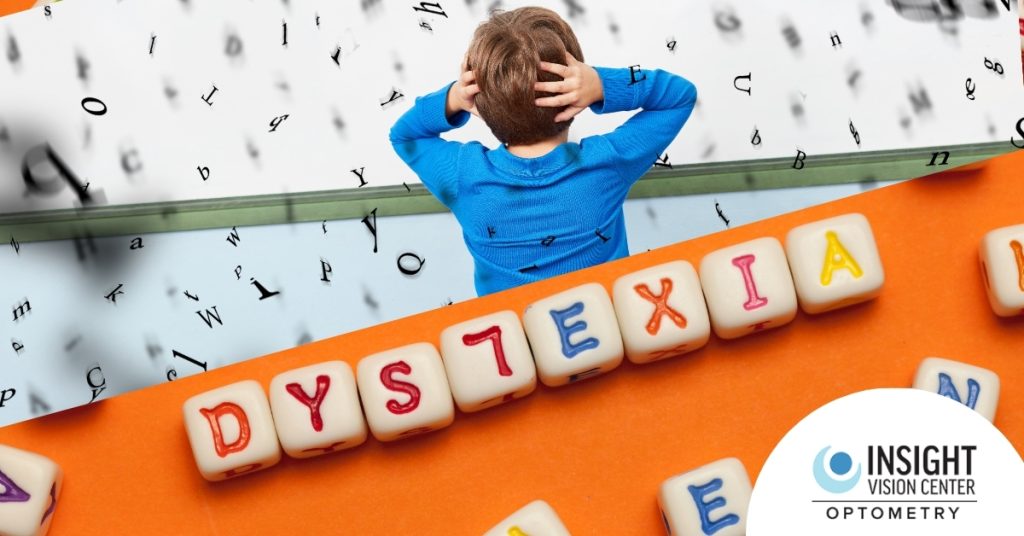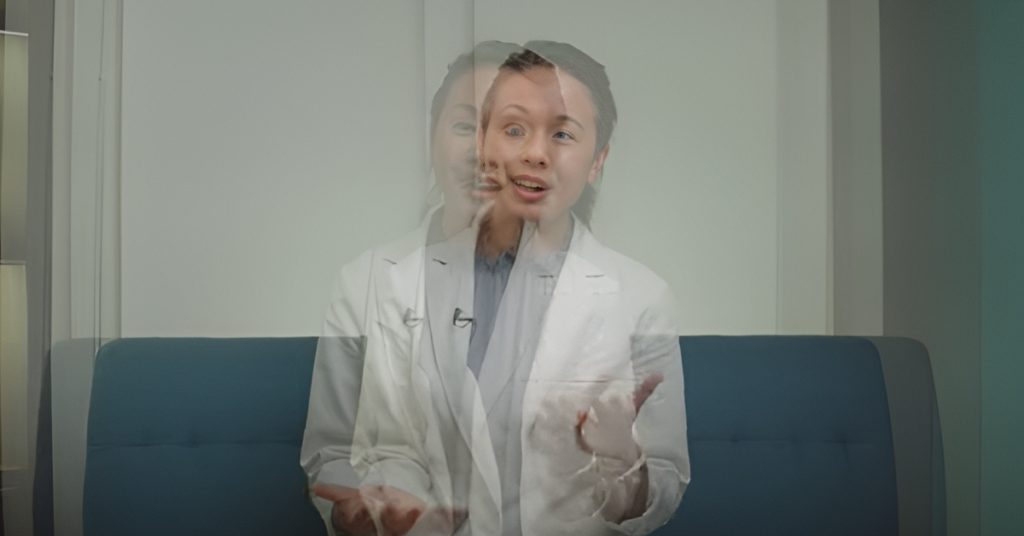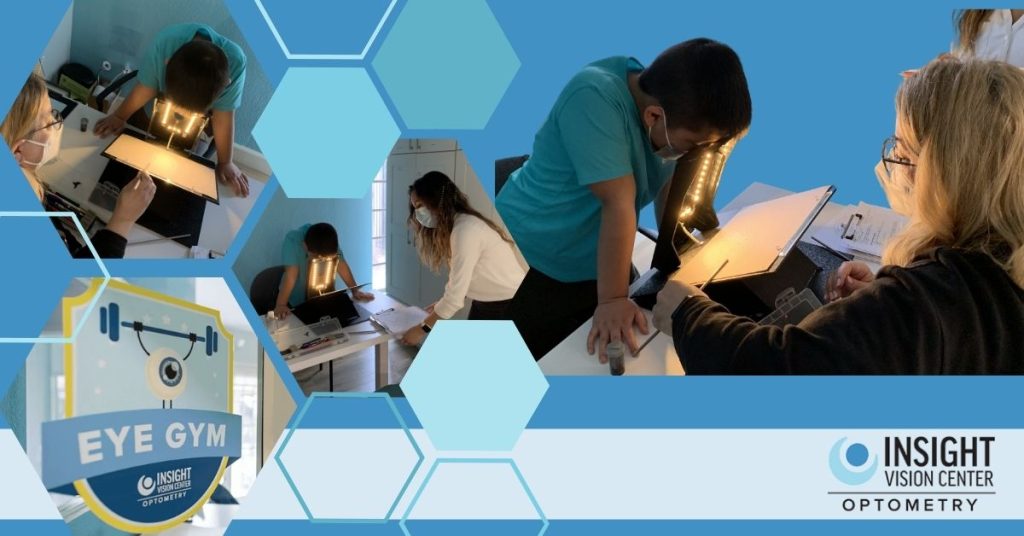At Insight Vision Center Optometry, located in Costa Mesa, California, we are passionate about empowering children to overcome barriers to their academic and personal success. Learning-related vision problems can present hidden challenges, affecting not just clarity of sight but also how the eyes function together and how visual information is processed by the brain. These issues often contribute to struggles with reading, attention, and comprehension, creating obstacles that traditional eye exams might not detect.
The Connection Between Vision and Learning Challenges
Research underscores the strong link between certain vision problems and academic difficulties. For instance, a Harvard Medical School study found that 79% of children with reading challenges also experienced issues with eye teaming, tracking, or focusing—compared to just 33% of proficient readers. These findings emphasize the importance of comprehensive vision assessments, including evaluations of sensorimotor functions, for children exhibiting learning difficulties.
At Insight Vision Center Optometry, we specialize in providing developmental vision evaluations tailored to uncover and address these hidden challenges. By identifying problems like convergence insufficiency, oculomotor dysfunction, or visual information processing deficits, we can craft personalized treatment plans designed to support your child’s success.
Understanding Learning-Related Vision Problems: What Are They?
- Visual Efficiency Problems
- Refractive Errors: Nearsightedness, farsightedness, and astigmatism.
- Accommodation Dysfunctions: Difficulty focusing on near or distant objects.
- Vergence Dysfunctions: Problems with eye alignment and teaming, such as convergence insufficiency.
- Ocular Motility Disorders: Issues with eye movements, affecting tracking and scanning abilities.
- Visual Information Processing Problems
- Visual-Spatial Orientation: Difficulty understanding spatial relationships.
- Visual Analysis Skills: Trouble recognizing and interpreting visual information.
- Visual-Motor Integration: Challenges in coordinating visual input with motor output (e.g., handwriting).
- Auditory-Visual Integration: Difficulty integrating auditory and visual information.
How Vision Problems Affect Learning
Impact on Academic Performance
Visual skills are fundamental to learning. When these skills are compromised, it can lead to:
- Reduced Reading Comprehension: Blurred or double vision can make text difficult to read, affecting comprehension.
- Slow Reading Rate: Difficulty tracking lines of text slows down reading speed.
- Poor Handwriting: Visual-motor integration issues can result in messy or illegible handwriting.
- Difficulty with Math Concepts: Visual-spatial problems can make understanding mathematical relationships challenging.
Behavioral and Emotional Effects
- Attention and Concentration Issues: Visual discomfort can make it hard to focus on tasks.
- Task Avoidance: Children may avoid reading or homework due to visual strain.
- Low Frustration Tolerance: Persistent difficulties can lead to frustration and decreased motivation.
- Impulsiveness: Struggling to process visual information can result in impulsive responses.
Associated Conditions
- ADHD: Attention Deficit Hyperactivity Disorder often co-occurs with learning-related vision problems.
- Dyslexia: A specific reading disability involving difficulties with word recognition and decoding.
Both ADHD and Dyslexic children have a higher likelihood of having developmental vision deficiencies. Furthermore the symptoms are often the same as those of a vision issue, making a developmental eye exam extremely important for these kids.
Signs and Symptoms to Watch For
Early identification of vision problems can make a significant difference in your child’s learning journey. Here are some signs to look out for:
Visual Efficiency Symptoms
- Frequent Headaches: Especially after reading or close work.
- Eye Strain or Fatigue: Complaints of tired eyes during or after school.
- Blurred or Double Vision: Difficulty focusing on words or letters.
- Losing Place While Reading: Skipping lines or rereading the same line.
- Difficulty Copying from the Board: Trouble transferring information from distance to near.
Visual Information Processing Symptoms
- Letter and Number Reversals: Confusing ‘b’ and ‘d’ or ‘6’ and ‘9’.
- Poor Reading Comprehension: Difficulty understanding or remembering what was read.
- Trouble with Spelling: Inconsistent or phonetic spelling errors.
- Difficulty with Math: Problems understanding spatial concepts or aligning numbers.
- Poor Handwriting: Messy, uneven spacing, or inconsistent letter sizes.
Behavioral Signs
- Short Attention Span: Especially during visual tasks.
- Avoidance of Near Tasks: Reluctance to read or do homework.
- Excessive Blinking or Eye Rubbing: Signs of visual discomfort.
- Poor Coordination: Difficulty with sports or activities requiring eye-hand coordination.
- Impulsive Behavior: Acting without thinking due to processing difficulties.
When to Seek Help
- Consistent Struggles: Ongoing difficulties in school despite effort.
- Teacher Concerns: Feedback from educators about attention or academic issues.
- Family History: Relatives with vision problems or learning disabilities.
With a deep commitment to the families of Costa Mesa and surrounding communities such as Irvine, Huntington Beach, and Santa Ana, our highly experienced team is equipped with advanced training and cutting-edge technology to diagnose and treat these complex vision issues. Our goal is to ensure that children throughout Orange County not only see clearly but also thrive in their educational pursuits.
Diagnosis: What to Expect
A developmental eye examination by a pediatric optometrist is crucial for diagnosing learning-related vision problems.
Components of the Examination
- Visual Acuity Testing
- Measures clarity of vision at different distances.
- Identifies refractive errors needing correction.
- Refraction
- Determines the exact prescription for glasses or contact lenses.
- Ocular Motility Testing
- Assesses eye movement control.
- Checks for tracking and fixation stability.
- Accommodation and Vergence Testing
- Evaluates focusing abilities and eye teaming.
- Identifies problems like convergence insufficiency.
- Visual Information Processing Assessment
- Tests skills like visual memory, spatial orientation, visual-motor integration, and rapid naming.
- Uses standardized tests to compare performance with age norms.
Reading Disabilities and Dyslexia

Understanding Dyslexia
It often stems from deficits in phonological processing.
Dyslexia is a specific learning disability characterized by difficulties with accurate and/or fluent word recognition and by poor spelling abilities.
Visual Components of Dyslexia
- While dyslexia is primarily language-based, visual deficits can exacerbate symptoms.
- Visual-Spatial Orientation Problems
- Difficulty distinguishing similar letters (e.g., ‘b’ vs. ‘d’).
- Visual-Motor Integration Issues
- Challenges in writing letters correctly and legibly.
- Visual Attention Deficits
- Struggling to focus on specific words or letters.
Assessment for Dyslexia
- Phonological Awareness Tests
- Assess the ability to manipulate sounds in words.
- Reading and Spelling Evaluations
- Identify patterns in errors and difficulties.
- Visual Processing Tests
- Determine if visual deficits are contributing to reading challenges.
Importance of a Multidisciplinary Approach
- Effective management often requires input from:
- Pediatric Optometrists: Address visual efficiency and processing issues.
- Educators: Implement appropriate teaching strategies.
- Speech-Language Pathologists: Work on language processing skills.
- Psychologists: Provide cognitive assessments and support.
Treatment of Vision-Related Learning Problems in Children
Even 20/20 Vision Isn’t the Whole Story
You might think that because your child has perfect “20/20” eyesight, vision problems aren’t affecting their learning. However, vision is much more than just the ability to see clearly at a distance. Even children who can read the eye chart flawlessly may still struggle with visual skills essential for learning.
Beyond Visual Acuity
Visual acuity refers to the sharpness of vision at a distance, such as reading letters on a wall chart. While important, it’s just one aspect of comprehensive vision health. Other critical visual functions can significantly impact your child’s educational performance, even if they have perfect distance vision.
Key Visual Skills Related to Learning
Consider the following essential visual skills that play a crucial role in your child’s ability to learn effectively:
1. Eye Movement Skills (Ocular Motility)
- What It Is: The ability of the eyes to move smoothly and accurately across a line of text.
- Why It Matters: Efficient eye movements are essential for reading. If your child’s eyes skip or jump unpredictably, they may lose their place or have difficulty comprehending what they’re reading.
2. Eye Focusing Abilities (Accommodation)
- What It Is: The capacity to quickly and accurately maintain clear vision as the distance from objects changes.
- Why It Matters: In a classroom, children often need to shift focus from the chalkboard (far) to their desk (near) and back again. Difficulty with this skill can lead to blurred vision and eye strain.
3. Eye Teaming Skills (Binocular Fusion)
- What It Is: The ability of both eyes to work together in a coordinated manner.
- Why It Matters: Proper eye alignment is necessary for depth perception and reading. Issues like convergence insufficiency, where the eyes don’t work together at near distances, can cause double vision and headaches.
4. Binocular Vision Skills
- What It Is: The blending of images from both eyes into a single, three-dimensional image.
- Why It Matters: This skill is crucial for understanding spatial relationships and for activities that require depth perception, such as reading maps or participating in sports.
5. Visual Perceptual Skills
- What It Is: The ability to interpret and understand visual information.
- Why It Matters: This includes recognizing letters and numbers, understanding symbols, and making connections with previously learned material. Deficits can affect reading comprehension and math skills.
6. Visual-Motor Integration
- What It Is: The coordination of visual information with body movements.
- Why It Matters: Essential for tasks like writing and drawing, as well as for sports. Poor eye-hand coordination can lead to messy handwriting and difficulty copying information from the board.
How Vision Problems Affect Learning
Undetected vision problems are common and can significantly hinder a child’s academic performance. In some cases, children with vision issues may be misdiagnosed with behavioral problems or conditions like ADHD/ADD because they exhibit similar symptoms, such as inattention or hyperactivity.
Possible Consequences of Untreated Vision Problems
- Academic Struggles: Difficulty reading, writing, and concentrating can lead to poor grades.
- Behavioral Issues: Frustration from vision problems may result in acting out or withdrawing.
- Misdiagnosis: Vision problems might be mistaken for learning disabilities or attention disorders.
- Social Challenges: Children may avoid activities they find difficult, impacting social interactions.
Prevalence of Vision-Related Learning Problems
- Convergence Insufficiency: Studies indicate that approximately 13% of children aged 9 to 13 suffer from moderate to severe convergence insufficiency. This condition affects the eyes’ ability to work together at close range and is crucial for reading.
- Learning-Related Vision Problems: Research shows that one in four school-age children has at least one learning-related vision problem.
Signs and Symptoms to Watch For
Identifying vision-related learning problems early can make a significant difference in your child’s educational experience. Be attentive to the following signs:
Common Symptoms
- Double Vision: Particularly during or after reading.
- Blurred Vision: Especially after prolonged near work.
- Eye Strain or Frequent Headaches: Often associated with visual tasks.
- Poor Handwriting: Messy or illegible writing that may indicate visual-motor integration issues.
- Word and Letter Reversals: Mixing up ‘b’ and ‘d’ or ‘p’ and ‘q’.
- Easily Distracted During Reading: Difficulty maintaining focus on visual tasks.
- Poor Reading Comprehension: Struggling to understand or remember what was read.
- Avoidance of Reading: Reluctance to engage in reading or other close work.
- Hyperactivity or Restlessness in Class: May stem from discomfort during visual tasks.
- Overall Poor School Performance: Despite effort, grades do not reflect the child’s potential.

Signs and Symptoms of Learning-Related Vision Problems
Children May Be Unaware of Their Vision Issues
It’s important to recognize that children with vision problems are often unaware of their condition. They may assume that everyone sees the world as they do, making it crucial for parents and educators to be vigilant in observing signs that might indicate a vision-related issue affecting learning.
Common Physical Signs and Symptoms
These are some of the more noticeable signs that may suggest your child is experiencing vision problems:
- Squinting: May indicate difficulty focusing or seeing clearly.
- Excessive Blinking: Could be a response to blurred vision or eye strain.
- Excessive Eye Rubbing: Often a sign of eye fatigue or discomfort.
- Tearing, Red, Itchy, or Burning Eyes: May suggest eye irritation or strain.
- Holding Objects Close to the Eyes: Indicates potential nearsightedness.
- Headaches or Eye Strain: Especially after reading or close work.
- Blurry Vision or Double Vision: Difficulty focusing at certain distances.
- Eye Turn (Strabismus): One eye may turn in, out, up, or down.
- Turning or Tilting the Head: Could compensate for double vision or misalignment.
- Covering or Closing One Eye: May help the child see better if eyes aren’t working together.
Behavioral Signs and Symptoms
Vision problems can also manifest in behaviors that might not immediately seem related to eyesight:
- Avoidance of Near Work: Dislikes activities like reading or playing with small objects (e.g., Lego).
- Short Attention Span: Particularly during tasks that require visual concentration.
- Daydreaming During Work Time: May appear disengaged due to visual discomfort.
- Skipping Words, Letters, or Lines: Difficulty tracking text when reading or copying.
- Using a Finger or Moving the Head to Track While Reading: Compensating for tracking difficulties.
- Trouble Remembering What Was Read: Poor comprehension due to visual processing issues.
- Delayed Learning of the Alphabet: Difficulty recognizing and remembering letters.
- Persistent Letter, Number, or Word Reversals: Common in writing and reading.
- Problems with Laterality: Confusion between left and right directions.
- Not Completing Assignments on Time: Visual tasks may take longer due to difficulties.
- Difficulty with Geometric Shapes: Challenges in visual-spatial processing.
- Poor Hand-Eye Coordination: Affects writing, drawing, and sports activities.
- Behavior Problems: Frustration from vision issues may lead to acting out.
Academic and Learning-Related Signs
These symptoms are often observed in a school setting and can impact academic performance:
- Struggles in Reading: Slow reading pace, frequent errors, or avoidance.
- Homework Is a Battle: Resistance to starting or completing assignments.
- Poor Attention and Concentration: Easily distracted during visual tasks.
- Letter Reversals: Writing ‘b’ instead of ‘d’, ‘p’ instead of ‘q’, etc.
- Poor Handwriting: Messy or illegible writing due to visual-motor integration issues.
- Headaches with Reading: May complain of discomfort after sustained reading.
- Words Overlap or Go Double: Indicative of binocular vision problems.
- Losing Place When Reading: Difficulty tracking lines of text.
- Blurriness When Reading: Especially after prolonged near work.
- Motion Sickness: Discomfort during movement, possibly linked to visual-vestibular integration.
- Difficulty Riding a Bike: Challenges with balance and spatial orientation.
- Difficulty Planning: Trouble organizing tasks or following sequences.
- Trouble with Math: Issues understanding spatial relationships and aligning numbers.
Detailed Symptoms and Possible Vision Problems
Understanding the specific symptoms can help identify the underlying vision issues:
1. Blurred Vision, Frequent Eye Rubbing, Squinting
- Possible Vision Problems:
- Nearsightedness (Myopia): Difficulty seeing distant objects clearly.
- Farsightedness (Hyperopia): Difficulty focusing on close objects.
- Astigmatism: Distorted or blurred vision at any distance due to an irregularly shaped cornea.
2. Closing or Covering One Eye, Occasional Double Vision
- Possible Vision Problems:
- Eye Coordination Problems: Inability to coordinate both eyes effectively (binocular dysfunctions).
- Strabismus: Misalignment of the eyes causing them to point in different directions.
- Amblyopia (Lazy Eye): Reduced vision in one eye due to poor development of normal sight during early childhood.
3. Holding Reading Material Very Close, Complaints of Blurred Vision
- Possible Vision Problems:
- Accommodation Issues: Difficulty maintaining clear focus on close objects or when shifting focus between distances.
- Convergence Insufficiency: Eyes do not work together when looking at near objects, causing double or blurred vision.
4. Excessive Head Movement When Reading, Losing Place
- Possible Vision Problems:
- Eye Tracking Problems (Ocular Motility Dysfunction): Difficulty smoothly and accurately moving the eyes from one point to another.
- Poor Saccadic Eye Movements: Challenges with rapid eye movements necessary for reading.
5. Mistakes Words with Similar Beginnings, Difficulty Recognizing Letters or Shapes
- Possible Vision Problems:
- Visual Form Perception Issues: Inability to discriminate differences in size, shape, or form.
- Visual Discrimination Problems: Difficulty noticing and comparing the features of different items.
6. Trouble Visualizing What Is Read, Poor Reading Comprehension
- Possible Vision Problems:
- Faulty Visual Memory: Difficulty remembering and recalling visual information.
- Visual Sequencing Issues: Challenges in remembering the order of letters, numbers, or words.
7. Sloppy Handwriting, Poor Copying Skills
- Possible Vision Problems:
- Visual-Motor Integration Deficits: Difficulty coordinating visual information with motor output.
- Eye-Hand Coordination Problems: Affecting writing, drawing, and other fine motor tasks.
8. Reverses Letters and Words, Trouble Learning Left and Right
- Possible Vision Problems:
- Laterality and Directionality Difficulties: Poor development of left/right awareness.
- Spatial Orientation Issues: Challenges understanding and remembering spatial relationships.
Treatment and Management Options

Corrective Lenses
- Glasses or Contact Lenses
- Correct refractive errors to improve visual clarity.
- May include advanced lenses for specific focusing needs.
Vision Therapy
A personalized program of visual activities designed to improve:
- Eye Coordination (Binocularity)
- Exercises to enhance how the eyes work together.
- Focusing Abilities
- Activities to improve near and distance focusing.
- Eye Movement Control
- Training to enhance tracking and scanning skills.
- Visual Processing Skills
- Tasks to improve visual memory, discrimination, and spatial orientation.
Components of Vision Therapy
- In-Office Sessions
- Typically conducted once or twice a week.
- Supervised by an optometrist or vision therapist.
- Home Support Activities
- Reinforces skills practiced during office sessions.
- Requires commitment to regular practice.
Educational Accommodations
- Classroom Adjustments
- Preferential seating to reduce visual strain.
- Allowing extra time for assignments.
- Providing handouts to minimize copying from the board.
- Assistive Technologies
- Audiobooks and text-to-speech software.
- Large print materials or high-contrast text.
The Importance of Early Detection
- Prevents Compounding Difficulties
- Early intervention can prevent academic struggles from worsening.
- Supports Developmental Milestones
- Ensures children develop necessary visual skills for learning.
- Enhances Confidence
- Reduces frustration and builds self-esteem.
FAQs About Learning-Related Vision Problems
Q1: Can standard vision screenings detect learning-related vision problems?
A: No, standard screenings typically only assess distance visual acuity. Developmental eye exams are necessary to evaluate visual efficiency and processing skills critical for learning.
Q2: Is vision therapy effective for all children with learning difficulties?
A: Vision therapy is effective for children with specific visual deficits. It is most beneficial when integrated into a multidisciplinary approach addressing all aspects of the learning difficulty.
Q3: How do I know if my child needs vision therapy?
A: If your child exhibits signs of visual efficiency or processing problems, a pediatric optometrist can conduct a comprehensive evaluation to determine if vision therapy is appropriate.
Q4: Will my child outgrow these vision problems?
A: While some visual skills develop with age, untreated vision problems can persist and continue to impact learning. Early intervention is key.
Q5: How long does vision therapy take to show results?
A: Some improvements may be noticed within weeks, but significant changes typically occur over several months, depending on the individual case and adherence to therapy.
Key Takeaways
Learning-related vision problems are a significant but often overlooked barrier to academic success. By understanding these issues and taking proactive steps, you can make a profound difference in your child’s educational journey.
- Developmental or Pediatric Eye Exams are Crucial: To identify vision problems that affect learning.
- Early Intervention Makes a Difference: Addressing issues early can prevent long-term academic struggles.
- Multidisciplinary Collaboration Enhances Outcomes: Working with educators and other eye doctors provides holistic support.
- Parental Involvement is Vital: Your support and advocacy are essential components of successful management.
Why Choose Insight Vision Center Optometry?

As a top-rated pediatric eye care clinic in Orange County, our Costa Mesa children’s vision eye doctor practice serves as a hub for families across the region, including Santa Ana, Irvine, Huntington Beach, Tustin, Fountain Valley, and Anaheim. Our team’s expertise in pediatric optometry and vision therapy, combined with a compassionate approach, ensures a comprehensive and effective solution for each child.
We invite you to explore how developmental vision care at Insight Vision Center Optometry can transform your child’s learning journey. Schedule an appointment today and discover why families trust us to provide exceptional care across Orange County. Call us at (714) 942-1361 or book online to schedule your child’s appointment.





